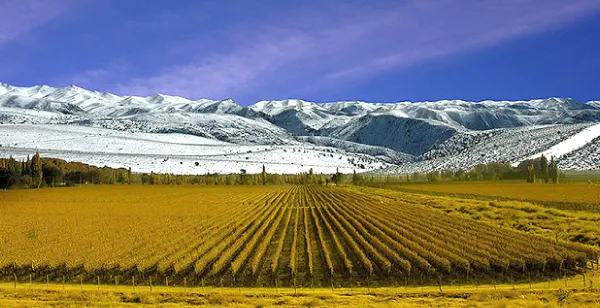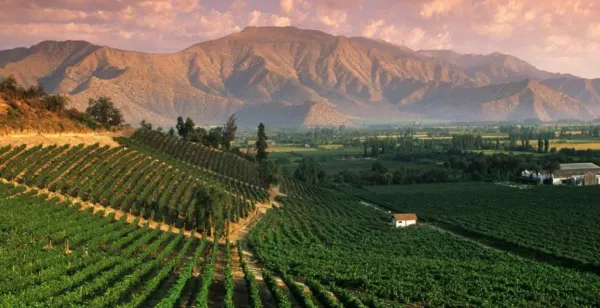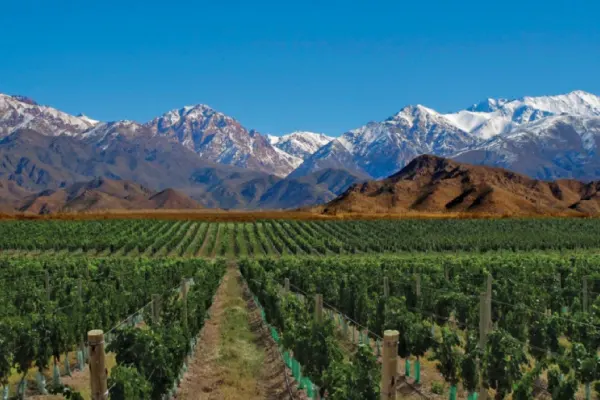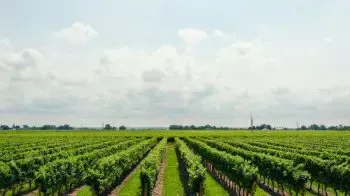Viniculture in Argentina started in 1551, when Spanish colonists brought different grape varieties to start production. Good weather conditions helped to boost activity in the center and north of the country, where the colonizers were located. At that time, the monks developed their own production with their own archaic system, with American grape varieties that produced a sweeter wine.
At the end of the 18th century, there were 10,000 hectares of vineyards and already in the early 1990s, there were more than 200,000 hectares.
Argentina is nowadays among the five largest wine producers in the world, with approximately 217 thousand hectares of vineyards planted, a production of three million boxes annually and exports of 25% of its production.

Image: Vinitude - Clube dos Vinhos
Argentina
Located in South America, it is a country of vast territory. It is the second largest territory in South America and is also the third most populous country in that continent, behind Brazil and Colombia. It is bathed by the Atlantic Ocean and borders Bolivia, Brazil, Chile, Paraguay and Uruguay.
The Argentine territory covers an area of 2,766,889 km², where approximately 40.2 million inhabitants live.
Argentine Terroir
Argentina's climate is arid and dry. The interior of the country is marked by the action of the Zonda wind, formed by the cold breezes coming from the South Pole, through Chile. That same wind, descends to the lower plains and affects above all three sub-regions: La Rioja, San Juán and Mendoza, which has consequences for winegrowing, such as sunstroke, great intensity of ultraviolet light, little rain and need of irrigation to avoid lack of water in the plants.
Argentine soils are predominantly sandy and the irrigation system is often made by flooding, which facilitates the absorption of water by the roots of the vineyards.

Image: Turismo Acessivel
Argentine Wine Regions
Argentina is made up of ten wine regions organized into three groups: North, Cuyo and Patagonia and the Atlantic Region.
Northern Group
Jujuy: located in the extreme northwest of the country. The most planted grape variety in this region is Malbec and the wines are full-bodied, with an almost black color, marking the identity of wines of extreme altitude.
Salta: marked by the presence of altitude vineyards, the area begins to be cultivated at 1530 meters and reaches 3111 meters. The locality of Cafayate is the center of reference for viticulture in the North, concentrating 75% of the vineyards in Salta.
Catamarca: the region has a very dry, arid continental climate, and its soils are sandy and deep. The grape with the highest cultivation in this region is Torrontés Riojano.
Tucumán: the high altitude, the influence of the sun, the mild winds and the sandy loam soils that the Tucuman wine has bright colors, simple aromas with sweet, fruity and ripe flavors. The most planted grape varieties in this region are Malbec, Cabernet Sauvignon and Torrontés.
Cuyo Group
Mendoza: this region concentrates 75% of the total vineyards in Argentina. It is the most important wine region and one of the main producing centers in the world. It has 20% of the total area of Malbec grapes planted in the country, although Bonarda, Cabernet Sauvignon, Syrah and Tempranillo also stand out here.
San Juan: it is the second largest wine region in importance and volume in Argentina, with 17% of the total planted area in the country. The climate is hot and dry, which is reflected in the quality of the wines. The predominant grape variety in this area is Syrah.
La Rioja: consisting of valleys, warm weather and temperate nights. The Torrontés variety is native to this area, which makes it predominant. The wines of this region are of medium structure and of moderate acidity.

Image: Instinto Viajante
Patagonia and Atlantic Region Group
Neuquén: in this region, wine production is concentrated in the southeast of the territory. It has a hot climate, cold nights and strong dryness. The wines of this region have a high concentration of color, a high level of fruity aromas, are full-bodied and structured.
Rio Negro: the wines of this region are characterized by having a good ratio of alcohol and acidity, product of a slow ripening of the grapes.
La Pampa: located in the center of the country, it presents a moderate continental climate, having mild autumns and springs, hot summers and cold winters.
Buenos Aires: composed of a set of hills and wavy plains of little height. It has a humid climate, a lot of wind and low thermal amplitude. Here we can find fresher and more elegant wines of high aromatic complexity.
Chubut: it constitutes the most southern point for the cultivation of vineyards in Argentina. Region of extreme cold, strong winds and the presence of frosts throughout the season, which produces fresh wines, with fruity notes and good acidity.
Types of Argentine wine
Argentine wines are very expressive, fruity, complex wines, with good structure and concentration in the mouth. They are very versatile, since they can be consumed very young or after a few years.
Grape Varieties from Argentina
In Argentina we can find a wide variety of grape varieties, everything depends on the region we are in:
Jujuy: Cabernet Sauvignon, Malbec, Merlot, Sauvignon Blanc and Syrah.
Salta: Cabernet Sauvignon, Malbec, Tanta and Torrontés.
Catamarca: Bonarda, Cabernet Sauvignon, Malbec and Syrah.
Tucumán: Cabernet Franc, Cabernet Sauvignon, Malbec, Merlot and Torrontés.
Mendoza: Bonarda, Cabernet Sauvignon, Malbec, Syrah and Tempranillo.
San Juan: Bonarda, Cabernet Sauvignon, Malbec, Syrah and Torrontés.
La Rioja: Bonarda, Cabernet Sauvignon, Malbec, Syrah and Torrontés.
Neuquén: Cabernet Sauvignon, Chardonnay, Malbec, Merlot and Pinot Noir.
Río Negro: Cabernet Sauvignon, Malbec, Merlot, Pinot Noir and Torrontés.
La Pampa: Cabernet Franc, Cabernet Sauvignon, Chardonnay, Malbec and Merlot.
Buenos Aires: Cabernet Sauvignon, Chardonnay, Malbec, Merlot and Sauvignon Blanc.
Chubut: Chardonnay, Malbec, Merlot, Pinot Noir and Torrontés.
 Portugal
Portugal Spain
Spain France
France Germany
Germany United Kingdom
United Kingdom Monaco
Monaco



